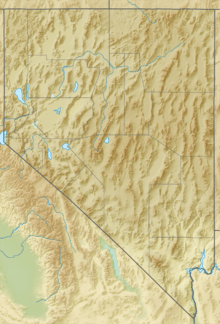Egan Range facts for kids
Quick facts for kids Egan Range |
|
|---|---|

Ward Mountain in the Egan Range, looking north from the White River Valley.
|
|
| Highest point | |
| Peak | Ward Mountain |
| Elevation | 3,333 m (10,935 ft) |
| Naming | |
| Etymology | Howard Egan (Nevada surveyor) |
| Geography | |
| Country | United States |
| State | Nevada |
| District | White Pine County |
| Range coordinates | 39°26′20.771″N 115°1′45.090″W / 39.43910306°N 115.02919167°W |
| Topo map | USGS Robinson Summit |
The Egan Range is a cool line of mountains located in White Pine County, in eastern Nevada, in the western United States. These mountains stretch for a long distance. They are named after the Egan family, specifically Howard Egan, who was an important surveyor in Nevada's history.
Exploring the Egan Range
The Egan Range begins near Egan Creek. This is close to the historic community of Cherry Creek. From there, the mountains run south for about 108 miles (173 km). They even extend into the northern part of Lincoln County, past a peak called Shingle Peak.
Where is it Located?
The Egan Range is surrounded by other interesting places. To the east, you can find the wide Steptoe Valley. Beyond that is the even longer Schell Creek Range. To the west, there is the White River Valley. You can also see the beautiful White Pine Range there.
Looking north from the Egan Range, you'll find the Cherry Creek Range. If you look south, you'll see a quiet area called Cave Valley. This is also where the southern tip of the Schell Creek Range is located.
The Highest Points
The southern part of the Egan Range gets taller and taller. It climbs up to a high ridge known as Ward Mountain. This high part is over 3 miles (5 km) long. It reaches elevations up to 10,936 feet (3333 meters). This makes Ward Mountain the highest point in the entire Egan Range.
As you move north from Ward Mountain, the mountains quickly get lower. They drop to elevations below 6,200 feet. This lower area is near the community of Ely.
Northern Peaks
North of Ely, the Egan Range starts to rise again. One of these northern peaks is Heusser Mountain. It stands at 9,411 feet (2,868 meters) tall. This mountain is about 5 miles west of the community of McGill.
This northern group of mountains continues to rise. It includes Telegraph Peak, which is 9,918 feet (3,023 meters) high. After Telegraph Peak, the mountains get lower again. They eventually reach Egan Creek. Here, the Egan Range almost connects with the Cherry Creek Range.


